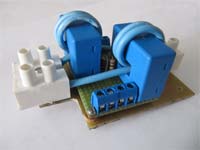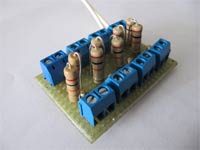



Murovannyi Igor
- Electrotechnical faculty
- Chair "Electric drive and automation of industrial complexes"
- Speciality "Electromechanical automation systems and electric drive"
- "Tools development for registration of dynamic transients in the electric drive system"
- Scientific adviser: Chekavskyy Glib
- Consultant: Khomenko Vyacheslav
Review of master's work
Main part
Current transducers
Voltage transducers
Determination of character of measureable signals
The choice of analog-to-digital converter
List of references
Introduction
Studying the special disciplines in the area of Electromechanics, students often face with a concept "Transients". Quite often they also investigate behavior of one or another system of electric drive "in dynamics". Planning the system of electric drive on a production the basic requirements are produced to its dynamic characteristics, i.e., to quality of transients.
Becomes clearly, that transients are one of major aspects at the study of electric drive. The analysis of transients can be done both with an educational and with research aim. But, in the conditions of the university labs the possibility to see transients in electric drive "alive" is limited, and, as a result, knowledge by the students one of the basic divisions of special subject ends with a theory, but don’t reach the practice. So, tools development for registration of transients in the electric drive system becomes an actual task enough. The worked out tools will allow with sufficient exactness to visualize transients. In addition, students will get possibility to confirm the gained knowledge in practice.
The aim of work is a receipt of numeral values of the measured sizes with their further computerising. Under further treatment we mean the filtration of signal (if necessary), selection of the first harmonics of signals, calculation of unknown coordinates, the construction of diagrams of transients. For example, on the recieved values of currents and tensions of asynchronous motor and using the known methodologies it’s need to expect the values of magnetic flux and moment.
For the achievement of this aim it is necessary to decide the task of development of recording system which would satisfy next requirements: recording system must conduct registration of coordinates with the small enough sample time, including in the mode of on - line with the subsequent processing of data by means of the computer programs; recording system must be characterized by a compactness, mobility (with the purpose of simple transfer him from one laboratory stand to other), by universality in relation to measureable signals, both on amplitude and on the sort of current.
Main part
In the generalized kind one registration channel can be presented, as shown on pic.1.

Picture 1 — Generalized scheme of registration channel
On a picture it is marked: GI is a galvanic isolation; CA is a co-ordinating amplifier; ADC is an analog-to-digital converter; PC is the personal computer.
To realize the block of galvanic isolation and co-ordinating amplifyer maybe, using the modern sensors of current, tensions, speeds of and other. Basic support during registration is done, certainly, on currents and tensions. It is explained to those, that in an asynchronous motor on the known values of currents and tensions it is possible to expect other coordinates, and in most DC motor, used in laboratories, tachometer generator is set, transforming speed in tension.
Current transducers
For realization of galvanic isolation the current transducers LA 55-P of LEM are chosen. A nominal measureable current for these transducers is 50 A, that fully sufficiently for measuring of current in the motors set in the laboratories of university.
Sensors are mounted on PCB (printed circuit board), two on a board. On boards there are all necessary contacts for the serve of supply voltage and for an output signal. Original appearance of sensors is shown on a picture 2.

Picture 2 — Original appearance of current transducers
Voltage transducers
For lowering of voltage to the level acceptable to the boards of analog-to-digital converters the board of voltage dividers (pic. 4) was worked out. Attitude of output voltage toward input one for a voltage divider is 0,025. It allows at 380 V on input to get 9,2 V on output. But the voltage divider does not provide a galvanic isolation between a power circuit and measuring chain, therefore to give output voltage of the divider straight on the input of analog-to-digital converter is impossible. To order galvanically to untie a measuring channel from a power circuit, the block of galvanic isolations GISA-01С is used.

Picture 3 — Original appearance of voltage dividers
Except the board of voltage dividers the voltage transducers are used also on the basis of Hall’s effect of LV 25-P of LEM, counted on voltage 10-500 V.
Determination of character of measureable signals
With the purpose of determination of character of measureable signals, and also with the purpose of determination of necessary parameters of analog-to-digital converter pre-registration of signals subject to the further measuring and treatment was conducted. Registration was conducted by means of industrial recorder of signals "РЕКОН-08МС" [5] on the experimental stands of laboratory of control system of the electric drive of department "Electric drive and automation of industrial complxes".
The choice of analog-to-digital converter
Pre-registration of signals showed, that a converter must provide a sample time of one channel no less than 20 kHz during registration of signals in the electric drive of alternating current, and no less than 1 kHz in the electric drive of direct-current. The range of input voltages of converter must make approximately ±10 V, oriented on the current and voltage transducers. The analysis of the products presented at the market showed, that these requirements are satisfied by the microsystem of acquisition of data with the interface of USB m-DAQ of production of company Holit Data Systems. Microsystem of acquisition of data m-DAQ widely used in educational aims in many educational establishments. It is explained, firstly, by simplicity in exploitation, secondly, by a relatively low cost.
Important note
In the moment of writing of this abstract master's degree work is not yet finished. Final completion of work will take place in December, 2011. In the near future it is planned to conduct registration of signals in the different systems of electric drive by means of microsystem of acquisition of data m-DAQ. It is also planned to conduct registration of the same signals by means of analog-to-digital converter National Instruments 6023E and conduct the comparative analysis of these two devices.
List of references
- Калинов А.П., Гладырь А.И. Универсальное учебно-исследовательское оборудование для электромеханических лабораторий // Електротехнічні і енергозберігаючі системи. Науково-виробничий журнал. Випуск 1/2007 (1). — Кременчук. — С. 14—19.
- Данилов А. Современные промышленные датчики тока / Андрей Данилов // Современная электроника. — 2004. № 10. — С. 26—35.
- Фрайден Дж. Современные датчики. Справочник / Дж. Фрайден; пер. с англ. Ю.А.Заболотная. — Москва: Техносфера, 2005. — 592 с.
- Калинов А.П. Учебно-исследовательское оборудование на базе универсальных модулей АЦП / А.П.Калинов, Д.Г.Мамчур, А.И.Гладырь // ПиКАД. — 2008. № 4. — С. 42—45.
- Чекмарев А. Датчики тока и напряжения ABB — от печатной платы до преобразователей-гигантов / Алексей Чекмарев // Силовая электроника. — 2006. № 3.
- Инструкция по эксплуатации многоканального регистратора электрических сигналов «РЕКОН-08МС» (версия 7.24). — Донецк: «РЕКОН», 2002. — 34 с.
- SAMI MINISTAR Frequency Converter. Technical Information. — ABB Drives, 1991. — 32 p.
- БТУ-3601. Техническое описание и инструкция по эксплуатации, 1982. — 46 с.
- Micromaster 440. Руководство по эксплуатации. Документация пользователя. Издание А1. — Siemens AG 2007. — 140 с.
- Dorin O. Neacsu. Space vector modulation — an introduction / IECON'01: The 27th Annual Conference of the IEEE Industrial Electronics Society. IEEE, 2001.
- Литвин Н.А. Инновационные подходы к организации практикума по основам технологии сбора данных и программированию / А.Н.Литвин, Е.Ю.Хохлова, А.М.Литвин // ПиКАД. — 2009. № 1. — С. 18—22.